Hello everyone and welcome to this week's article!
This time we're going to talk about a free amp profiler that's being developed by Steven Adkinson, and it's a software that is currently under development but it can already work decently and has seen the birth of a huge internet community (here).
NAM is an amp simulator which features the most common controls and an IR loader, but that bases its uniqueness on the fact that you can load into it models which are snapshots of real rigs (in a way similar to what IK Multimedia Tonex and Kemper profiling amp do).
Which are the differences between NAM and the other profilers? The difference is the fact that this one is in beta, is has a less polished interface and still needs some refinment, but the fact that it's free and that has a sound quality that has nothing to envy to the other profilers makes up for everything!
What's the different from an amp simulator and an amp profiler? An amp simulator emulates the way a circuit reacts, while a profiler takes a test tone and makes it pass through a real rig (which can be an amp, or a pedal, or even hardware mixing outboard) and tries to recreate how the hardware reacts adapting these cues to its structure, with results usually more true-to-life than the regular simulators.
I am not sure if I have explained it with the correct words, but the result is that profilers are in the last few months disrupting the amp sim scene which has been dominating the last 20 years, and in the case for example of NAM there is a large community online which is sharing its captures (hundreds!) and you can download them freely and try them out: some are good, some are bad, but it's really amazing to see all this ferment around this tool, and really all you need to do is to install the Vst (which can be downloaded here), load it in your DAW, add a cabinet simulator, load the model you want from those you downloaded and treat it like any other amp sim.
Now let's see toghether if you have a real amp, for example a tube head, and you want to create a profile of it, what to do (you can see more also on this video):
- first off setup your computer for reamping (you'll need to connect your audio interface to the input of your amp via a reamp box, click here for a dedicated guide).
- download the training wav file here, create a new project in your DAW at 24bit 48khz and load this file into a mono track.
- reamp the training file through your rig and record the resulting output file into a new mono track, which will basically be the training file which has passed through your amp and has acquired all the characteristics, for example of the overdrive channel.
- Normalize and export the reamped file (exactly of the same lenght of the training file) in mono at 24bit and 48khz and rename it "output.wav".
- go to this page and upload the output.wav file and the training wav file in the root folder on the left as per the image in the point of the arrow 1 (click on the pic to enlarge it):
- once the files are uploaded click on the space between the brackets pointed by the arrow 2, it will start loading and this will take around 10 seconds.
- once the loading part is completed click on the space between the brackets pointed by the arrow 3, and it will start loading again. This process can take some time, around 10 minutes, but at the end if everything went according to the plan you will receive an output file into a folder indicated at the end of the process. You can download this output file (with the extension .NAM) and load it directly into the plugin, and if everything went well you will have a faithful replica of your amp!
What do you think of this plugin? Do you think amp profilers will completely replace the amp sim world?
Let us know in the comments below!
Become fan of this blog on Facebook! Share it and contact us to collaborate!!


















